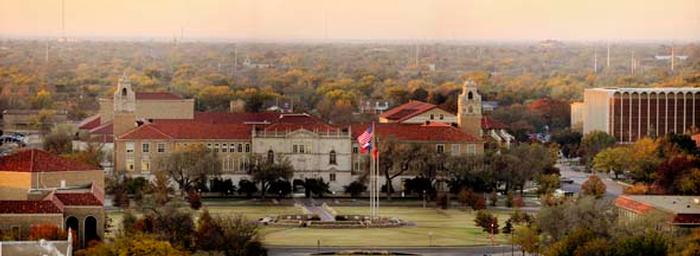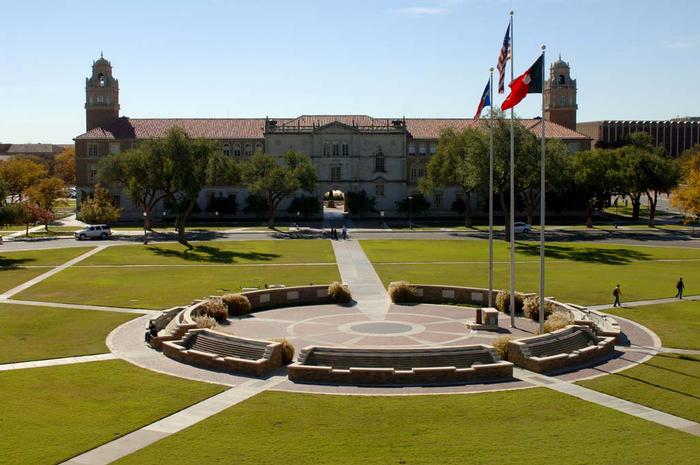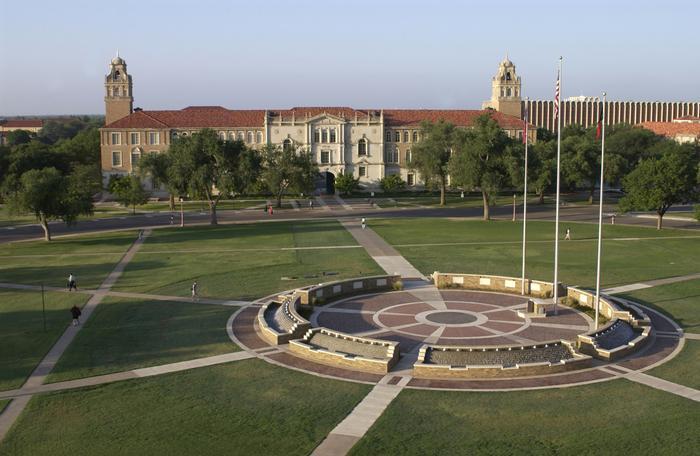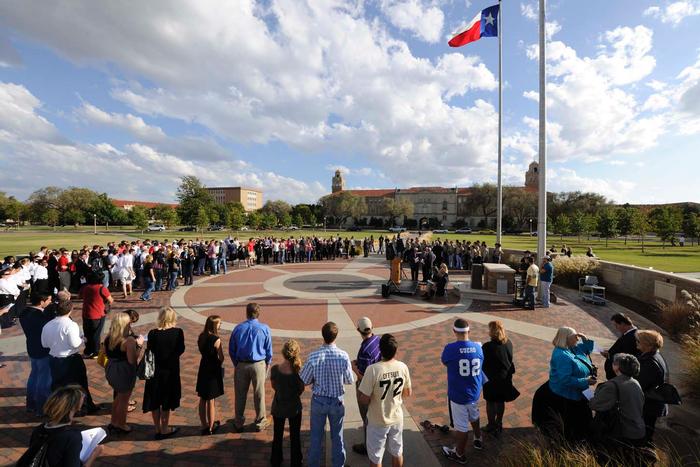[ID:129] Memorial CircleUnited States For me, “sacred” used to only have religious connotations, but I have come to realize it can mean more than that. It is a place where a person can become better connected with themselves by finding peace in their everyday, chaotic life. Today’s busy world allows very little down time for most people. Multi-tasking has taken on a life of its own, to the point of distraction. On the college campus especially, students have some type of portable electronic device going at all times. There are very few places in the world where one can be quiet and contemplate, simply reflecting on where they have been and where they are going. To me a place of refuge to escape everyday life is a sacred place, and one of the hardest to find. We all need a place to escape the chaos, a refuge in this busy world, even if it is just for a moment.
That place for me is Memorial Circle on the University of Texas Tech’s campus. In 1948 following World War II the area was dedicated by the Tech War Veterans Association “to all whose service has brought honor to college and country.” Cars, busses, bicycles and students flow by and through the memorial forming a constant stream of activity. Memorial circle is peaceful because of the way it allows someone to feel disembodied and remember the important things in life. It reminds us that the important things in life are the people that we care about. I know that I can forget that sometimes, and the memorial helps bring me back to my center. I think of the grandfather that I never had the chance to know who gave his life in WWII for us. Reflecting back to when as a child, I attended the reunion of the few men that survived the sinking of his ship and listening to their stories of life at sea, and that frightful day; the memorial service honoring not only him, but all who lost their lives when the ship went down; the sound of the twenty-one gun salute in Arlington National Cemetery marking the event; and that everyone has lost someone dear.
Memorial circle is surrounded on three sides by academic buildings and to the east is one of the major parkways connecting the campus to the city streets of Lubbock. Of all the places to be able to find a quiet place to reflect, outdoors at the center of campus would be one of the least likely places. Memorial Circle started out one dimensional and flat. It was simply a paved twelve foot circle located on the spot where seven sidewalks intersect in the middle of campus. These walkways were and are still terminals for thousands of students in their daily trek across campus. Located at the very heart of the circle is a sundial. Later in 1967 the main campus flag poles with the national, state and university flags were moved to the circle and placed just off center to the west side, where they can be viewed from University Avenue. It was not until 2002 that the Pfluger Fountain was added to the outside edge of the memorial. This really brought emphasis to the memorial, and set it apart from the surrounding environment. The fountain is actually a series of curved fountains that were built to frame the circle providing openings into the circle by each of the walkways. The fountains were built with solid stone walls reaching just over four foot tall on one side and dropping down to only a two foot edge, with the high wall facing the inside of the circle. Within each fountain is a brick staircase with water cascading down and outwards toward the roadway and buildings that surround them.
As the journey begins through memorial circle, one first crosses the open space toward the fountains. You can hear and feel all the hustle and bustle of daily life on the campus, rushing people and traffic. Everyone is on a mission to somewhere, distracted and involved in their own world. When approaching the fountains, the soft sounds of the trickling water can be heard. The fountains having the ability to heighten a person’s senses with the water’s sound calming and lulling into a state of relaxation, pulling you out of the trance you are in. The splashing and gurgling noises of the water build and echo around the circle and begin to overtake the traffic noise as you draw nearer. When walking to the entrance, there comes a point when the sounds of water envelop you and cancel the outside noises of chaos and traffic. Once you cross the threshold to the inner circle the water softly fades, leaving the space void of sounds, you are now alone and in a different world. The traffic noise ceases and the water sounds have all but disappeared. This space provides serenity within the bustling campus. The fountains can make a person feel like they have been transported to an island. The way the fountains are shaped and designed facing outward, the walls combined with the water noise, blot out the outside noise and distractions, creating a bubble effect that allows a person to feel alone, safe and quiet. I was shocked the designers and builders went through so much effort to give students this place of remembrance and solace by which to pass through. It has the ability to transform, you almost feel yourself getting lost within the walls, and slowing down to take a deep breath. This space is sacred to everyone who will take the time to notice it.
Thousands of students pass through it daily with their ipods on; music cranked; headphones in their ears; and chatting on cell phones so distracted that they never realize what is happening around them. I too had walked this path before never realizing the effects the design had on the environment around me. To some it is just considered a large expanse of wasted space that they must pass through to get to class. They are so caught up in where they are going; they never realize where they are. Some walk through this space every day without realizing that when you enter on one side of the Memorial Circle and exit on the opposite side, you have gone through this transformation of awareness.
For those that take the time, it can be a special moment in an otherwise hectic day. It allows one a few moments to truly feel peace and block out the rest of the world. It is an oasis or refuge from our daily hectic lives and a time to reflect on those whom have walked this path before us. Space that gives a person peace and encourages us to reflect, needs to be cherished and saved. When I pause, I think of those whose footsteps have long ago faded, did their lives go the direction they planned while in same place. While each person has their own unique history, we also have the bond of our nation’s history. This space reminds us of the price paid by those that came before us and lessons learned by both individuals and country. An appreciation for those who have paved the way for us is something we as a society cannot afford to forget. If we do not learn from our past, mistakes can be repeated. We all need to take pause and listen to the voices of those who came before us.
To change the space architecturally I purpose that a portion of the floor should be lifted by two or three steps to give the effect of a platform for people to speak on. This would give more awareness to the fact that this is not just a path but a destination. It would give the area more of a feeling of stepping into a different space or environment. It would also provide versatility to the space, so it could be used for anything from memorials to weddings. There needs to be singular chairs within the circle, for people who would like to stop and pause for a moment to reflect, or who need to study and would like to do so outside without distracting sounds. The chairs need to be movable so they can be used for whatever the situation dictates but so that they will not impede on traffic coming and going through the circle. By diversifying the space it would be used more often which means that more people will be drawn here and become aware of the effects that architecture can have on a person’s senses. Allowing people to pause here and encouraging them to remember others and their sacrifices. Moments like what the fountain provide, are needed in everyday life. I hope that by the space being enhanced that more people will understand that this is a place of refuge and refection.
When tour guides walk their visiting groups through here, they need to take a brief moment to explain the significance and the impact of the memorial. Allowing everyone to pause and remember why it was originally constructed. Most seem to just state this area is known as “Memorial Circle”, perhaps they do not realize the effects of the structure in this environment. If they would actually make it a destination on their tours, instead of simply a way to get somewhere else it would provide an appreciation with future residents. This would also provide visitors with a better understanding of the memorial and its significance. Hopefully by just making these two simple changes the space will no longer be just a terminal for people passing though on their daily journeys, but a destination.
Our biggest fear as a society should be lack of awareness of our surroundings. We see the effects of this problem reflected in many ways throughout our society. We all are so distracted with the use of personal electronics; it is easy to become immune to the outside world around us. Middle class families around the world no longer drive on family vacations to see our country; we would rather fly because we are in a hurry to get there, and rush back to work. The vacation is no longer road trip, and stopping at places of interest along the way, but the destination. If families do drive, they eat in the car, talk on cell phones, put headphones on to listen to music, even watch movies, and have stopped looking around us. We have stopped appreciating the time together on road trips, seeing our country and honoring our history.
Neglect of older buildings and monuments is becoming a silent epidemic in our nation and around the world. We see the effects of neglect, decay and graffiti on both old buildings and monuments in big cities and small towns throughout the country. We as a society must take the time to appreciate our country’s memorials and buildings. I would not want this space to fall into that category, because it is just another fountain, it is so much more. The fountain being on campus to me is significant because we as students are so busy planning our futures. We are making decisions that can, and will possibly affect the rest of our lives. Before those decisions are made, we need to step back, and not rush into them, without first looking at the big picture. Soon we will be the faded steps, what will we leave the next generation. We all get so wrapped up in our daily activities that we forget today will simply become a yesterday when tomorrow arrives. Forgetting to cherish and appreciate our surroundings is something we have all been guilty of at some point in our lives.
We all need to remember architecture not only leads us into our future; it verifies the present; and reminds us where we have been. According to former senator and decorated war veteran Bob Dole monuments are not really built for those that served but for our children to remember. “For them, our war is ancient history and those who fought it are slightly ancient themselves. Yet, in the end, they are the ones for whom we built this shrine and to whom we now hand the baton in the unending relay of humidity possibility.”
If you would like to contact this author, please send a request to info@berkeleyprize.org. |




